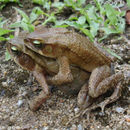Brief Summary
provided by IABIN
Diagnosis (1) A medium sized species for the group crucifer (snout-vent length 57.0-76.4mm in males; 60.4-83.9mm in females); (2) head slightly wider than long, no clear subdivision between head and body in dorsal view; (3) snout sub-elliptical in dorsal view; (4) low cranial crests; (5) small triangular parotoid glands, never exceeding the lateral edges of body dorsally; (6) first tubercle of lateral row always connected to the parotoid gland; (7) in life, absence of yellow marks near the cloaca and on posterior surface of thighs; (8) triangular sub-ocular band conspicuous, contrasting, well delimited; (9) a row of small tubercles on the ventral surface of tarsus, never forming a fringe.
- author
- Esteban O. Lavilla
- editor
- Diego Arrieta
Distribution
provided by IABIN
Distributed throughout the Atlantic Rain Forest from the State of Paraná to southern State of Santa Catarina and areas of the northern State of Rio Grande do Sul, limited by the hills of Serra do Mar to the north and Serra Geral to the west.
- author
- Esteban O. Lavilla
- editor
- Diego Arrieta
Diagnostic Description
provided by IABIN
Adult morphology A medium sized species of toad (snout-vent length 57.0-76.4mm in males; 60.4-83.9mm in females); robust build; no clear subdivision between head and body in dorsal view; head slightly wider than long; small parotoid glands, usually not subdivided, triangular, enlarged on anterior portion, sometimes elliptical, never exceeding the lateral edges of body dorsally; first tubercle of lateral row always connected to parotoid gland; snout sub-elliptical in dorsal view, sub-acute in lateral view; low cranial crests, with pre-ocular sometimes absent; moderate orbital ridge; roof of head concave; eyes protruding; width of upper eyelid about 60% of interorbital distance; nostrils prominent; inter-nostril region straight, bordered by canthal ridges; canthus rostralis straight; loreal region moderately concave; choanae large, rounded to elliptical; tongue oval, long, free, wider on posterior portion; tongue length about twice its width; vocal sac single, subgular, moderately developed; a line of small keratinized tubercles starting at the corner of mouth and finishing near the arm insertion; eye-nostril distance about 74% of eye diameter; inter-nostril distance smaller than tympanum diameter; tympanum distinct, large, generally rounded when free, elliptical when associated to the supra-tympanic ridge. Forelimbs long, diameter of forearm generally comparable to upper arm; hands medium sized; fingers long, slender, slightly fringed; webbing absent; relative lengths of fingers II
- author
- Esteban O. Lavilla
- editor
- Diego Arrieta
Rhinella abei: Brief Summary
provided by wikipedia EN
Rhinella abei is a species of toads in the family Bufonidae. It is endemic to southeastern Brazil where it occurs in eastern Paraná, eastern Santa Catarina, and northern Rio Grande do Sul. Its natural habitats are lowland Atlantic Forest below 1,000 m (3,300 ft) asl. Its habitat is suffering from degradation and fragmentation caused by logging (in the past) and clearance for agriculture and coastal development, posing threats to this species.

Rhinella abei in
amplexus
- license
- cc-by-sa-3.0
- copyright
- Wikipedia authors and editors



 Rhinella abei in amplexus
Rhinella abei in amplexus